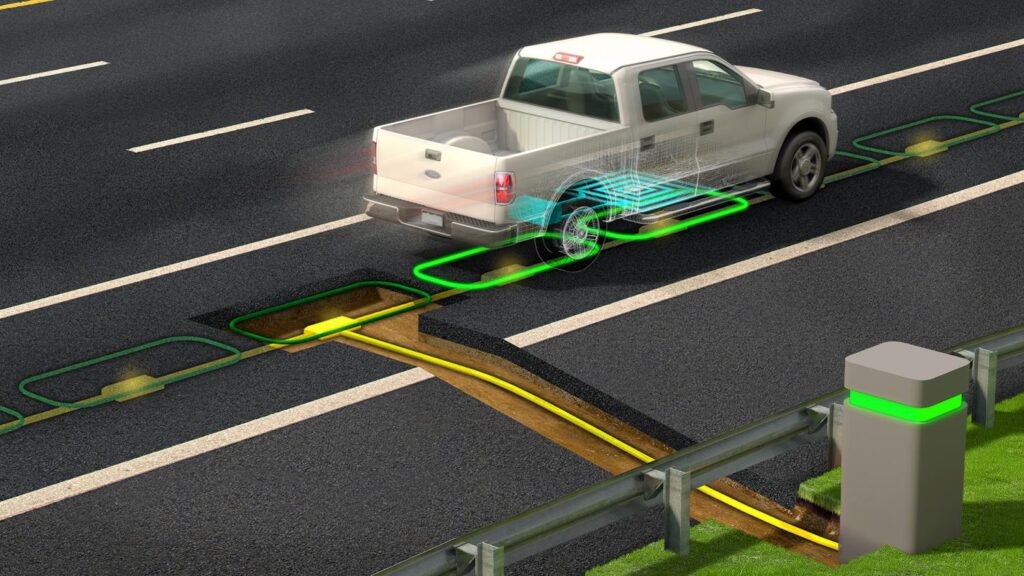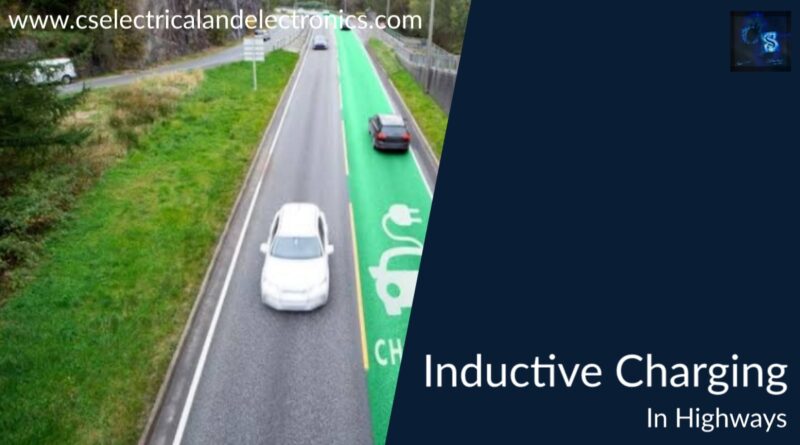Inductive Charging E-mobility, Inductive Charging In Highways
Hello guys, welcome back to our blog. Here in this article, we will discuss inductive charging e-mobility, inductive charging in highways, its purpose, working, benefits of inductive wireless charging, and its history.
If you have any electrical, electronics, and computer science doubts, then ask questions. You can also catch me on Instagram – CS Electrical & Electronics.
Also, read the following:
- Applications Of Artificial Intelligence (AI) In Renewable Energy
- Products Manufactured By Infineon Technologies Company In Detail
- What Is FreeRTOS, Purpose, Working, Configuration, Applications
Inductive Charging In Highways
In the 19th century, particularly under Nikola Tesla, electromagnetic induction was initially used to transport energy. In general, it enables the transfer of electrical current without a connection. A coil produces a magnetic field when it is given an electric current, and a second coil can use that magnetic field to create another electric current. Thus, a transmitting coil can convey a current to a receiving coil in terms of wireless technology. Recent technological advancements in this area have made contactless charging options for electric vehicles a reality.
Static and dynamic recharging systems are the two strategies that are currently being tested. The first mechanism keeps the car immobile without requiring a connection, much like a typical recharging station. The second approach is far more promising since it uses emitting coils buried beneath the road’s surface to allow the vehicle to be recharged as it moves. This method, which has undergone testing in various nations, might hasten the switch to electric automobiles.
Planning to implement
The Arena Del Futuro project is located in Chiari, a 1,050-meter (0.65-mile) loop of the road near the Chiari exit of the A35 Motorway, about 30 minutes outside Milan in northern Italy. Stellantis, the parent company of Fiat, Chrysler, Dodge, Chrysler, Jeep, Opel, Peugeot, Ram, Maserati, and many other brands, is a founding member of the project. This “Arena of the Future” was constructed to test a variety of cutting-edge transportation technology, such as enhanced 5G connectivity, Internet of Things concepts, V2X communications, and improvements to road surfaces.
However, its main objective was to evaluate and demonstrate the performance of wireless on-road charging systems, such as Dynamic Wireless Power Transfer (DWTP) technology from Stellantis. In order to lay down a series of flattish inductive charging coils and connect them to a power source, a few tiny grooves must be carved into the road surface before the DWTP can be installed. After that, more asphalt is placed on top.

When turned on, the coils provide power to passing vehicles as long as they are equipped with receivers. It’s interesting to note that it seems the energy is now delivered directly to the car’s electric motor. So that the EVs above may travel at highway speeds without using any battery power, the DWTP system simply takes over the role of supplying energy rather than charging the battery.
Stellantis reports that the results of the preliminary tests show that the power transfer efficiency is “similar to the normal efficiency of rapid charging stations.” The company claims that the related magnetic fields are safe for pedestrians to walk through and have “no effect on the driver and passengers.” Running on DC enables the DWTP to connect to renewable energy sources directly and effectively without the need for back-and-forth AC conversion, allowing for the use of very thin, compact cable.
So it is feasible and effective. However, it is unknown if or when the DWTP system will be implemented on public roads. This project has a number of chicken-and-egg issues that could make it more expensive than it is worth to get it off the ground on a commercial scale. These initiatives will only be financially viable if they are implemented along long lengths of heavily traveled roads if drivers can be fairly charged for their use, and if enough people purchase suitable vehicles.
Despite the promising test findings, it appears that widespread adoption of in-road charging will still need a number of costly leaps of faith. Since it can also be included in stationary EV charging stations, parking lots, airports, and the like, Stellantis claims the technology “attracts interest for commercial development globally.” However, nothing specific has been disclosed as of yet.
What Is Inductive Charging In Highways For Electric Vehicles?
Wireless power transfer is a sort of inductive charging. It is sometimes referred to as cordless or wireless charging. To supply power to a gadget, this technology uses electromagnetic induction.
It’s not necessary for the gadget to make electrical contact with a dock or outlet or to be exactly aligned. The charging station or pad initially applies alternating current to an induction coil.
The magnetic field generated by the flowing electric charge fluctuates in strength as a result of variations in the electric current’s amplitude. The induction coil of the apparatus produces an alternating electric current as a result. Finally, a battery is charged, or direct current is used to supply working power.
When using resonant inductive coupling, the inductive charging system adds a capacitor to each induction coil to produce two LC circuits with a specific resonance frequency. This makes it possible to place the sender farther away from the receiver coils.
The frequency of the alternating current is chosen based on the desired peak efficiency distance, and it matches the resonance frequency. It’s interesting to note that this resonant system has recently undergone improvements such as the use of a mobile transmission coil (i.e., mounted on an elevating platform or arm) and other materials for the receiver coil, such as silver-plated copper or occasionally aluminum, to lessen weight and skin effect resistance.
Electric Vehicles Charging Via Inductive Charging In Highways
Induction charging for smartphones—which frequently employs the Qi wireless charging standard—behaves similarly to wireless EV charging. When an electrical current passes through a coil, it generates an electromagnetic field that interacts with a second coil nearby to produce an equal electric current. The vehicle’s battery is charged by this current.
The automotive industry is now considering two applications for this scientific concept. These consist of wireless charging pads and wireless charging infrastructure built into roads.
How Wireless Inductive charging Works
With the use of a unique system of coils installed beneath the road surface to build a circuit just over 1 km long, this technology enables electric vehicles to recharge themselves. They provide electricity directly to automobiles, trucks, and buses with a total direct current output of 1,000 kW, eliminating the need for them to stop at stations to recharge the battery.
The system can be used in any car with a dedicated “receiver” that can transmit energy from the road infrastructure straight to the electric motor, improving the range and preserving the charge in the EV’s battery.

The system’s simple integration of various charging methods will result in shorter dwell times for charging, which will enhance the travel experience for the passenger.
Unquestionably, this new technology is supported by cutting-edge 5G and AI technologies that will enable communication between the vehicle and management systems.
The technology has already generated interest for potential future commercial developments in Italy and abroad due to its dynamic and static induction variables and versatility, which includes its application not only on roads and highways but also in other infrastructures such as ports, airports, and parking lots.
This was about “Inductive Charging In Highways“. I hope this article may help you all a lot. Thank you for reading.
Also, read:
- 10 Tips To Maintain Battery For Long Life, Battery Maintainance
- 10 Tips To Save Electricity Bills, Save Money By Saving Electricity
- 100 (AI) Artificial Intelligence Applications In The Automotive Industry
- 100 + Electrical Engineering Projects For Students, Engineers
- 1000+ Control System Quiz, Top MCQ On Control System
- 1000+ Electrical Machines Quiz, Top MCQs On Electrical Machines
- 1000+ MATLAB Simulink Projects For MTech, Engineering Students
- 50 Tips To Save Electricity At Home, Shop, Industry, Office
Author Profile
- Chetu
- Interest's ~ Engineering | Entrepreneurship | Politics | History | Travelling | Content Writing | Technology | Cooking
Latest entries
 All PostsApril 29, 2024Top 11 Free Courses On Battery For Engineers With Documents
All PostsApril 29, 2024Top 11 Free Courses On Battery For Engineers With Documents All PostsApril 19, 2024What Is Vector CANoe Tool, Why It Is Used In The Automotive Industry
All PostsApril 19, 2024What Is Vector CANoe Tool, Why It Is Used In The Automotive Industry All PostsApril 13, 2024What Is TCM, Transmission Control Module, Working, Purpose,
All PostsApril 13, 2024What Is TCM, Transmission Control Module, Working, Purpose, All PostsApril 12, 2024Top 100 HiL hardware in loop Interview Questions With Answers For Engineers
All PostsApril 12, 2024Top 100 HiL hardware in loop Interview Questions With Answers For Engineers








